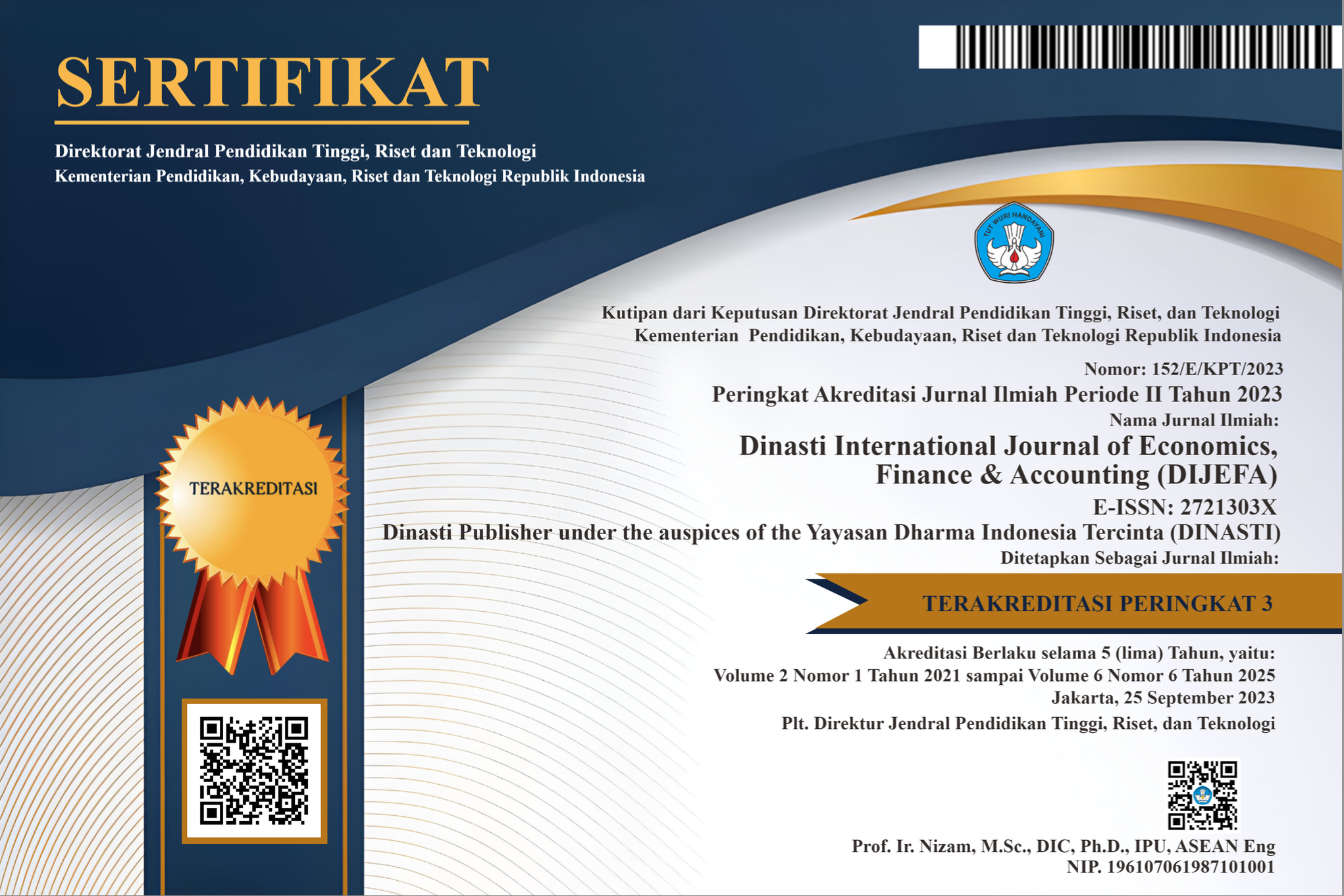The Dynamics of the Influence of Investor Sentiment on Capital Market Volatility in a Behavioral Finance Perspective
DOI:
https://doi.org/10.38035/dijefa.v6i3.4558Keywords:
Investor Sentiment, Capital Market Volatility, Behavioral Finance, Behavioral Bias, Financial Stability, ARCH-GARCH ModelAbstract
The dynamics of investor sentiment play a crucial role in the formation of capital market volatility, especially when psychological factors distort the supposedly rational decision-making process. In the perspective of behavioral finance, market behavior is influenced by collective emotions, cognitive biases, and information imperfections, which directly affect asset price movements and market stability. A secondary data-driven analysis from the period 2018 to 2023 of Indonesia's capital market indices indicates a significant correlation between fluctuations in investor sentiment and the level of market volatility. With the ARCH-GARCH model approach, it was identified that a surge in positive sentiment tends to increase volatility in the short term due to the overreaction effect, while the dominance of negative sentiment is associated with more prolonged selling pressure due to the influence of loss aversion and herding behavior. These findings reinforce the argument that markets are not entirely informationally efficient, but rather are heavily influenced by the collective perceptions and psychology of market participants. The implications of this study include the need to strengthen financial literacy based on investor psychology, reformulation of risk management strategies by market participants, and the development of policy instruments that are able to anticipate behavioral deviations from market rationality.
References
Adam, K., Marcet, A., & Nicolini, J. P. (2016). Stock market volatility and learning. The Journal of Finance, 71(1), 33–82.
Aggarwal, D. (2022). Defining and measuring market sentiments: A review of the literature. Qualitative Research in Financial Markets, 14(2), 270–288.
Agudelo Aguirre, R. A., & Agudelo Aguirre, A. A. (2024). Behavioral finance: Evolution from the classical theory and remarks. Journal of Economic Surveys, 38(2), 452–475.
Akerlof, G. A., & Shiller, R. J. (2009). Animal Spirits: How Human Psychology Drives the Economy, and Why It Matters for Global Capitalism. Princeton University Press.
Arias Abelaira, T., Rodríguez-Ariza, L., Pache Durán, M., & Texeira Fernandes Justino, M. do R. (2024). Determinants of digitization disclosure in IBEX-35 companies. Social Responsibility Journal, 20(10), 2279–2294.
Barberis, N., & Thaler, R. (2003). A survey of behavioral finance. Handbook of the Economics of Finance, 1, 1053–1128.
Benartzi, S., & Thaler, R. H. (2001). Naive diversification strategies in defined contribution saving plans. American Economic Review, 91(1), 79–98.
Black, F. (1986). Noise. Journal of Finance, 41(3), 529–543.
Bondt, W. F. M., & Thaler, R. H. (1985). Does the stock market overreact? Journal of Finance, 40(3), 793–805.
Chiu, C. J., Harris, R. D. F., Stoja, E., & Chin, M. (2018). Financial market volatility, macroeconomic fundamentals and investor sentiment. Journal of Banking & Finance, 92, 130–145.
Choi, Y., & Douady, R. (2012). Financial crisis dynamics: attempt to define a market instability indicator. Quantitative Finance, 12(9), 1351–1365.
De Bondt, W. F. M., & Thaler, R. H. (1995). Financial decision-making in markets and firms: A behavioral perspective. In Handbook of Experimental Economics (pp. 385–426).
Dorn, D. (2014). Investor sentiment and asset prices: A survey of the empirical literature. Journal of Economic Surveys, 28(1), 118–146.
Durnev, A., Li, K., Mørck, R., & Yeung, B. (2004). Capital markets and capital allocation: Implications for economies in transition. Economics of Transition, 12(4), 593–634.
Fama, E. F. (1970). Efficient capital markets: A review of theory and empirical work. Journal of Finance, 25(2), 383–417.
Fischer, C., & Hersch, P. L. (2006). Herding and overreaction in the stock market: Evidence from a market experiment. Journal of Behavioral Finance, 7(4), 194–201.
Gao, Y., Zhao, C., Sun, B., & Zhao, W. (2022). Effects of investor sentiment on stock volatility: New evidences from multi-source data in China’s green stock markets. Financial Innovation, 8(1), 77.
Gennaioli, N., Shleifer, A., & Vishny, R. W. (2015). Money doctors. Journal of Finance, 70(1), 91–116.
Gürkaynak, R. S., & Öztürk, E. (2020). Sentiment analysis in financial markets: A review. Journal of Economic Surveys, 34(4), 978–998.
Hirshleifer, D. (2015). Behavioral finance. Annual Review of Financial Economics, 7(1), 133–159.
Hwang, S., & Salmon, M. (2004). Sentiment, volatility, and the predictability of stock returns. Journal of Financial and Quantitative Analysis, 39(2), 349–374.
Kahneman, D., & Tversky, A. (1979). Prospect theory: An analysis of decision under risk. Econometrica, 47(2), 263–291.
Khorana, A., & Servaes, H. (2001). Herding behavior and the trading activity of institutional investors. Journal of Financial Economics, 59(1), 101–126.
Lintner, J. (1965). The valuation of risk assets and the selection of risky investments in stock portfolios and capital budgets. Review of Economics and Statistics, 47(1), 13–37.
Lintner, J. (1975). The valuation of risk assets and the selection of risky investments in stock portfolios and capital budgets. In Stochastic Optimization Models in Finance (pp. 131–155). Elsevier.
Malkiel, B. G. (2003). The efficient market hypothesis and its critics. Journal of Economic Perspectives, 17(1), 59–82.
Markowitz, H. M. (1952). Portfolio selection. Journal of Finance, 7(1), 77–91.
Minsky, H. P. (1977). A theory of systemic fragility. In Financial Institutions and the Role of Government (pp. 13–38).
Nafiu, A., Balogun, S. O., Oko-Odion, C., & Odumuwagun, O. O. (2025). Risk management strategies: Navigating volatility in complex financial market environments.
Peng, L., & Xie, F. (2021). Sentiment analysis in financial markets: Applications and research trends. Journal of Computational Finance, 25(2), 69–102.
Raghunathan, R., & Venkatraman, N. (2017). Behavioral decision theory in finance. Journal of Behavioral Finance, 18(2), 144–160.
Sahoo, S., & Kaur, M. (2020). Impact of sentiment on financial market volatility: Evidence from emerging markets. International Journal of Emerging Markets, 15(3), 551–574.
Shiller, R. J. (2000). Measuring bubble expectations and investor confidence. Journal of Psychology and Financial Markets, 1(1), 49–60.
Shiller, R. J. (2003). From efficient markets theory to behavioral finance. Journal of Economic Perspectives, 17(1), 83–104.
Slovic, P., Finucane, M. L., Peters, E., & MacGregor, D. G. (2007). The affect heuristic. European Journal of Operational Research, 177(3), 1333–1352.
Thaler, R. H. (1993). Advances in Behavioral Finance. Russell Sage Foundation.
Tversky, A., & Kahneman, D. (1974). Judgment under uncertainty: Heuristics and biases. Science, 185(4157), 1124–1131.
Verma, R., & Malhotra, N. (2015). Behavioral finance and financial markets: A study of behavioral factors impacting investors in India. International Journal of Business and Management, 10(3), 1–15.
Wang, Y., & Lee, W. (2013). The impact of investor sentiment on stock returns. Journal of Behavioral Finance, 14(4), 232–244.
Womack, K. L. (1996). Do analysts' recommendations add value? Journal of Financial Economics, 41(1), 3–28.
Zhang, X., & Zhou, X. (2017). Exploring the relationship between investor sentiment and stock price volatility: Evidence from emerging markets. Journal of Applied Finance, 27(2), 134–150.
Downloads
Published
How to Cite
Issue
Section
License
Copyright (c) 2025 Fahmi Roy Dalimunthe, Ekayana Sangkasari Paranita, Ade Suhara

This work is licensed under a Creative Commons Attribution 4.0 International License.
Authors who publish their manuscripts in this journal agree to the following conditions:
- The copyright on each article belongs to the author(s).
- The author acknowledges that the Dinasti International Journal of Economics, Finance & Accounting (DIJEFA) has the right to be the first to publish with a Creative Commons Attribution 4.0 International license (Attribution 4.0 International (CC BY 4.0).
- Authors can submit articles separately, arrange for the non-exclusive distribution of manuscripts that have been published in this journal into other versions (e.g., sent to the author's institutional repository, publication into books, etc.), by acknowledging that the manuscript has been published for the first time in the Dinasti International Journal of Economics, Finance & Accounting (DIJEFA).


























































